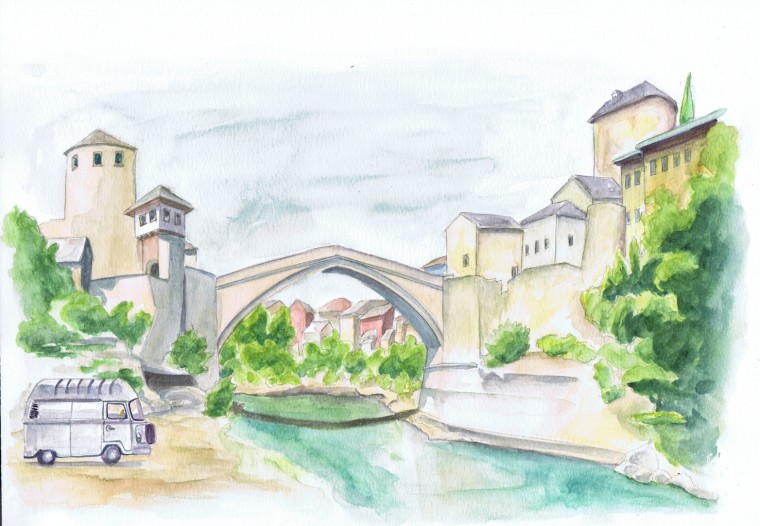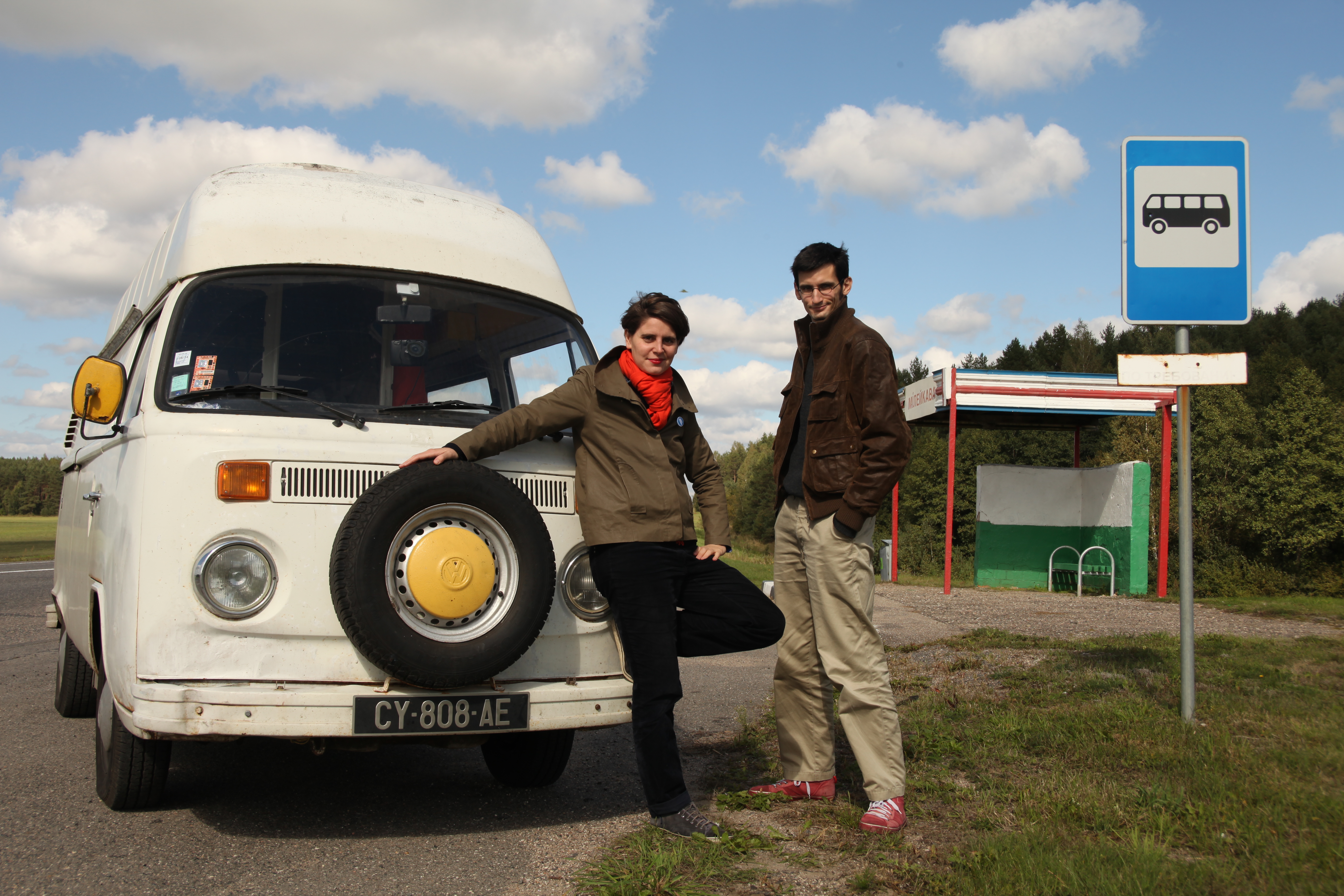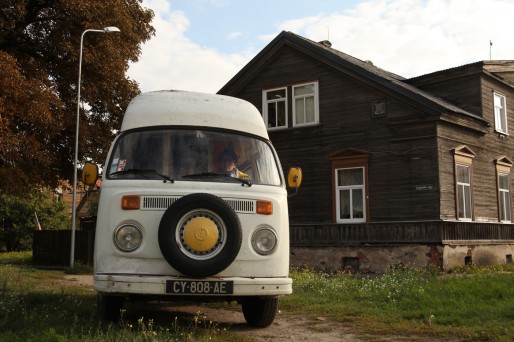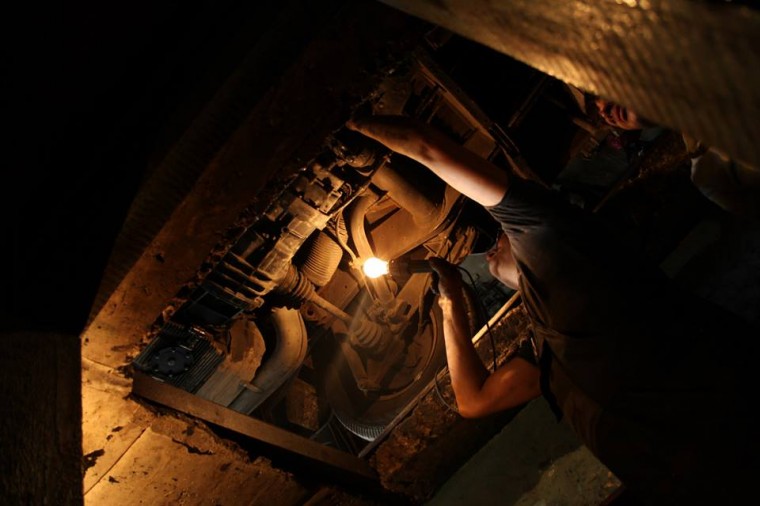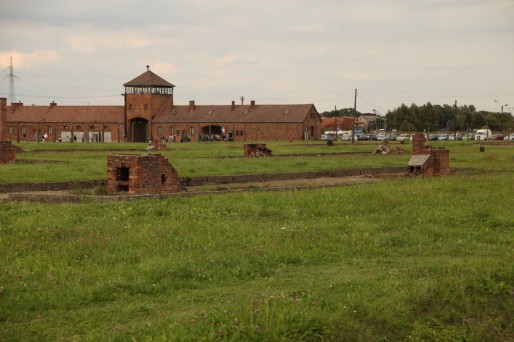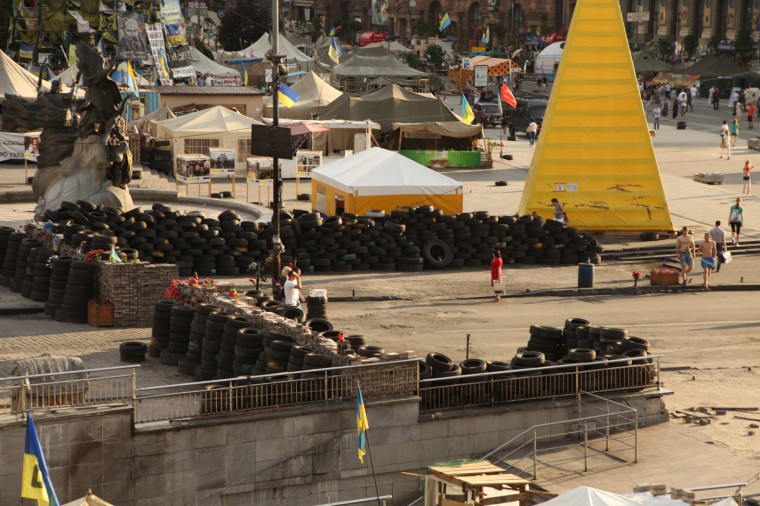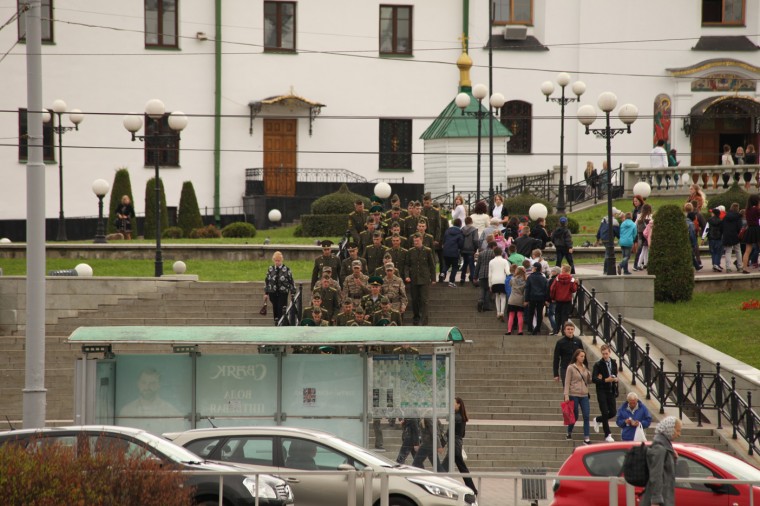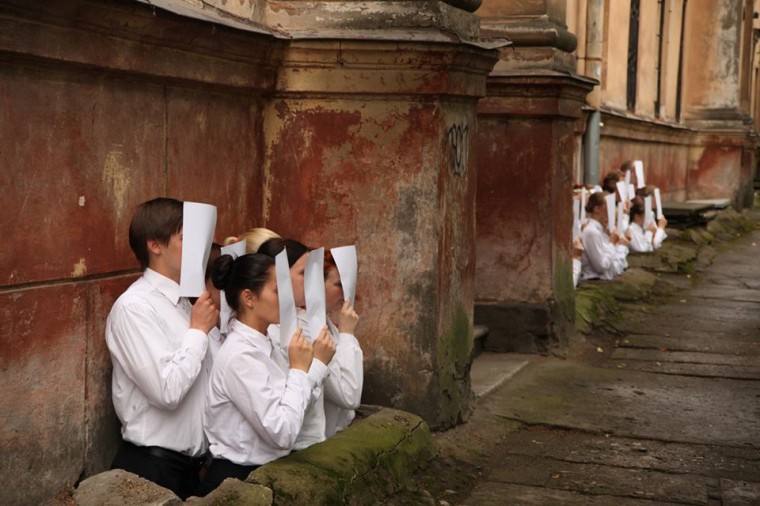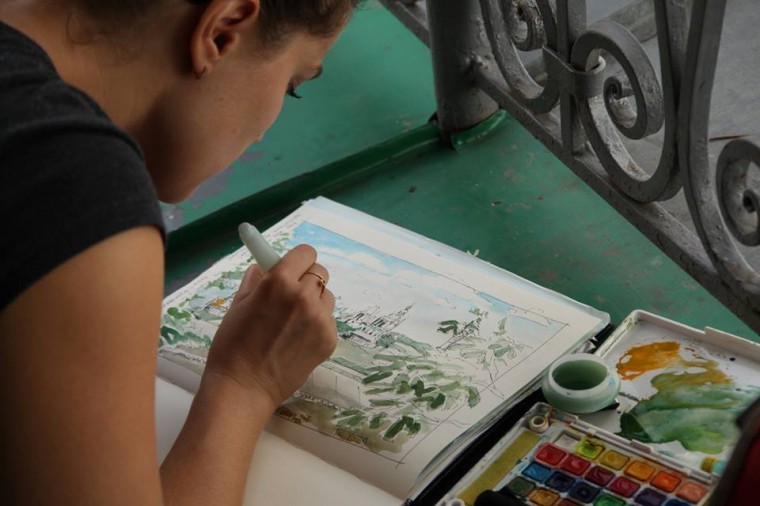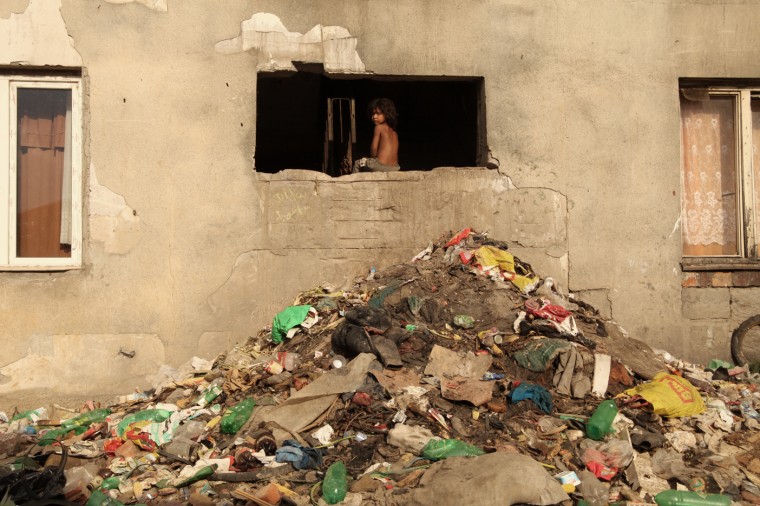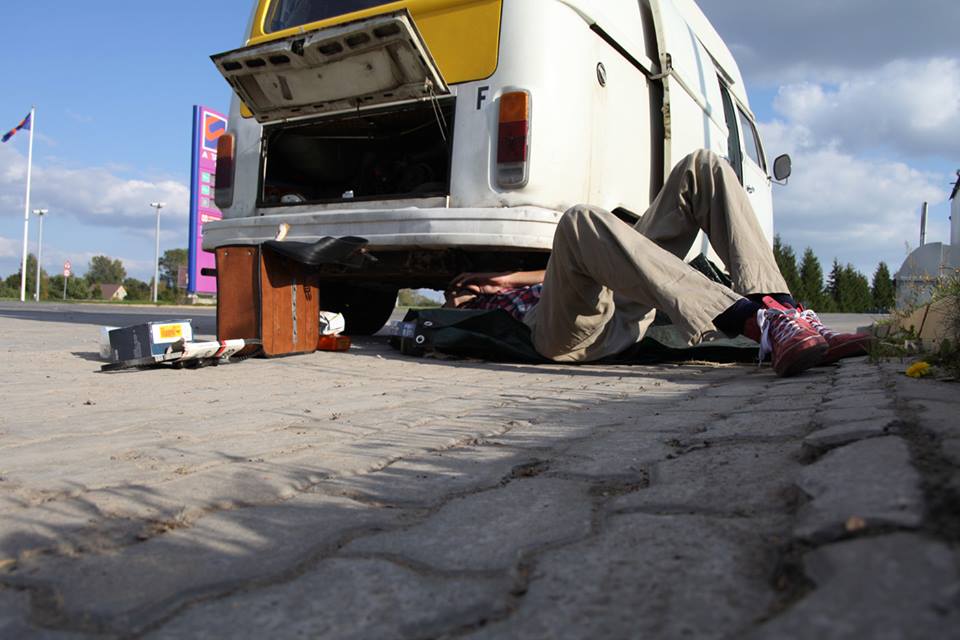Cette semaine, l’équipe du Bulli Tour Europa vous emmène au centre de « décontamination culturelle » de Belgrade, capitale serbe, et à Mostar, ville du sud de la Bosnie, où les Croates et les Bosniaques vivent toujours séparés, malgré les tentatives de quelques marionnettistes.
Le pont de Mostar, au-dessus de la rivière Neretva qui sépare les quartiers croate et bosniaque – Illustration Jonathan Bonard
À Belgrade, nos reporters se sont rendus au centre de « décontamination culturelle », créé en 1993 et qui devint un véritable espace de critique face au gouvernement serbe pendant la guerre de Yougoslavie. C’est par l’art que cette ONG combat le discours nationaliste et tente de rompre l’aliénation que subit la population par la « propagande gouvernementale » de Slobodan Milosevic. Aujourd’hui le centre dénonce toujours les regains de nationalisme et la corruption des élites politiques : « Le CZKD reste un espace de libre parole où se tiennent des discussions, des pièces de théâtres, des expositions », précise Ana Isakovic, qui souligne la nécessité de continuer la « décontamination » par l’art, notamment pour protéger les minorités ethniques, religieuses ou sexuelles, largement discriminées en Serbie.
C’est à Mostar, ville au pont célèbre, au sud de la Bosnie, que notre équipe a abordé la séparation des communautés croates et bosniaques. Ils sont allés à la rencontre d’une troupe de théâtre de marionnettes, qui s’est installée dans une ancienne synagogue, à l’atmosphère particulière. Cependant, un second théâtre de marionnettes cohabite dans la cité. Les leaders politiques semblent souhaiter maintenir la séparation des deux théâtres, tout comme la séparation des écoles, des institutions publics et des lieux culturels. Le multiculturalisme bosnien est alors réduit à une juxtaposition des communautés, juxtaposition justifiée par les tensions héritées de la guerre afin de préserver l’ordre. Cette perspective demeure peu réjouissante pour la jeunesse du pays, qui a soif de paix et de prospérité.
Notre équipe a ensuite repris la route à bord du combi VW. Retrouvez leur périple, entre Mostar et Skopje, à travers les montagnes balkaniques dans les carnets du Bulli sur Rue89 Strasbourg. À présent, le Bulli, qui a fait une étape à Skopje à la rencontre de la communauté rom et d’artistes macédoniens, vient de quitter la Bulgarie. Après une rencontre avec des membres du mouvement des indignés de 2013 à Sofia et la découverte de l’ancien siège du parti communiste à Buzludzha, notre équipe a pris le chemin de Svilengrad, à la frontière turco-bulgare, pour un reportage sur la situation des réfugiés aux portes de l’Europe et sur l’action des associations et des ONG sur place.
Chronicle of week n°6 : constructing and deconstructing the national cultures
This week, the crew of the Bulli Tour Europa leads you to the centre of « cultural decontamination » of Belgrade, the capital of Serbia, and in Mostar, a city of eastern Bosnia, where Croats and Bosnians still live apart, in spite of the attempts of a couple of puppeteers.
In Belgrade, our reporters went the centre of « cultural decontamination », created in 1993 it became a real space to criticize the Serbian government during the war of Yugoslavia. It was through art that this NGO fought the nationalist discourse and tried to break the alienation that the people had to undergo with the propaganda of the government. Today the centre still denounces the new rise of nationalism and the corruption among the political elite : « the CZKD remains a space of freedom of speech where there are discussions, theatre plays and exhibitions », Ana Isakovic explains, who underlines the necessity to carry on with the « decontamination » using art, notably to protect the ethnic, sexual or religious minorities, who are often discriminated against in Serbia.
It is in Mostar, a city whose bridge is famous, in eastern Bosnia, where our crew has tackled the issue of the separation of Croats and Bosnians communities. They met a group of puppeteers who work in a theatre, who has settled down in a former synagogue with a very peculiar atmosphere. However, another puppeteer troupe has also settled in the city. Whereas last year a common representation had allowed to gather the two groups, politicians do not want the two theatres mixing, they want to keep the separation of the two troupes, like the separation of schools, public institutions and cultural places. Therefore the Bosnian multiculturalism is reduced to a juxtaposition of communities, a juxtaposition justified by the tensions they inherited from the war in order to bring back order. This perspective brings no optimism to the youth of this country who is thirsty for peace and prosperity.
Then our crew set off again aboard the Volkswagen Transporter. You can follow their adventure from Mostar to Skopje, through the mountains of the Balkans in the « carnets du Bulli » on Rue89 Strasbourg. Now, the Bulli, after having stopped in Skopje to meet with the Roma community and Macedonian artists, is crossing Bulgaria. They met with members of the 15-M movement of 2013 in Sofia and the discovery of the former building of the Communist party in Buzludzha, our crew followed the road leading to Svilengrad, near the Turkish and Bulgarian border. There they had a good look at the situation of the refugees who are at the gates of Europe, the militarization of the border kept by the Frontex company and the actions of the associations and of the NGO to help the refugees.
Chronik der sechsten Woche : Konstruktion und Dekonstruktion der nationalen Kulturen
Diese Woche führt uns das Bulli Tour Europa Team in das Zentrum der “kulturellen Dekontaminierung“ von Belgrad, der Hauptstadt Serbiens und nach Monstar, einer Stadt im Süden Bosniens, wo Kroaten und Bosnier immer noch getrennt voneinander leben, trotz der Vermittlung einiger Puppenspieler.
In Belgrad besuchten unsere Reporter das Zentrum für “kulturelle Dekontaminierung“, welches 1933 gegründet zu einem wichtigen Ort wurde, um die serbische Regierung während des Jugoslawienkriegs zu kritisieren. Durch die Kunst kämpfte die NGO gegen den nationalen Diskurs und versuchte sich von der Propaganda, der die Menschen ausgesetzt waren, abzugrenzen. Noch heute, weist das Zentrum auf das neue Erstarken des Nationalismus und der Korruption in der politischen Elite des Landes hin: „die CZKD erinnert an die Redefreiheit, es gibt Diskussionen, Theaterstücke und Austellungen“ erklärt Ana Isakovic und unterstreicht damit die Notwendigkeit die „Dekontaminierung“ durch die Kunst weiter voranzutreiben, um ethische, sexuelle oder religiöse Minderheiten zu schützen, die in Serbien oft diskriminiert werden.
In Mostar, einer Stadt im Osten Bosniens, die berühmt ist für ihre Brücke, kommen unsere Reporter mit der Problematik der Separierung von kroatischen und bosnischen Gemeinschaften, in Berührung. Sie trafen eine Gruppe von Puppenspielern, die in einem Theater arbeiten, dass sich in einer ehemaligen Synagoge mit einer sehr speziellen Atmosphäre angesiedelt hat. Nichtsdestotrotz gibt es noch eine weitere Puppenspielergruppe in der Stadt und konnten sie letzten Jahr noch gemeinsam arbeiten, so wollen die Politiker die beiden Gruppen nun nicht mehr mixen. Es gilt eine Separierung, die sich auch in den Schulen, öffentlichen Einrichtungen und kulturellen Stätten wiederfindet. Dementsprechend ist die bosnische Multikultur auf ein Nebeneinanderher-Existieren beschränkt, die ihre Wurzeln in Strukturen findet, die die Spannungen des Krieges vermeiden sollen. Diese Perspektive schafft bei den jungen Menschen des Landes keinen Optimismus, dürsten sie doch so nach Frieden und Wohlstand.
Dann ging es für die Crew in ihrem Volkswagen Transporterr weiter, von Mostar nach Skopje. Verfolgen Sie ihre Expedition durch die Berge des Balkans in den „Bulli Notitzbüchern“ („carnet du Bulli“) auf Rue89 Strasbourg, denn nun ist der Bulli in Skopje, um eine Roma Gemeinschaft aus mazedonischen Künstlern zu treffen, die gerade durch Bulgarien reisen. Es folgt ein Treffen mit den Mitgliedern der 15-M-Bewegung, welches 2013 in Sofia gegründet wurde und der Besichtigung des ehemaligen Sitzes der kommunistischen Partei in Buzludzha. Unserer Reporter folgten der Straße nach Svilengrad, nahe der türkisch-bulgarischen Grenze und konnten sich so einen Eindruck machen, von den Bedingungen für die Flüchtlinge, die vor den Toren Europas warten, der Militarisierung der Grenzen durch FRONTEX und den Versuchen und konkreten Aktionen der Organisationen vor Ort, die versuchen den Flüchtlingen zu helfen.

